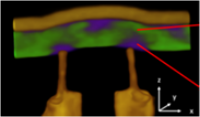
METSA-SET-DIA: Improving Scanning Electron Tomography Experiments Using Direct Electron Detectors and Innovative Algorithms
Responsible: Pascale Bayle-Guillemaud, IRIG/CEA Grenoble
Keywords: Tomography, scanning electron microscopy, 3D structure, three-dimensional chemical characterization, Energy Electron Loss Spectroscopy (EELS), ptychography, direct electron detection camera, nanoscale, atomic scale

DIADEM’s mission is to accelerate the development of new materials in France, by combining modeling, digital simulation, methodologies associated with artificial intelligence (AI), synthesis/screening technologies and high-throughput characterization in an integrated manner. METSA-SET-DIA contributes to the achievement of this mission by optimizing and developing three Tomography techniques in a transmission electron microscope in Scanning mode (Scanning Electron Tomography: SET), so that they are faster, more efficient and more efficient. automatic.
The three SETs chosen are complementary and have several points in common: EELS-SET for three-dimensional (3D) chemical characterization at the nanoscale (EELS: Energy Electron Loss Spectroscopy), Nano-SET and Ptycho-SET for structural characterization respectively at the nanometric and atomic scale. METSA-SET-DIA will rely on:
- the equipment and know-how present either on the NanoCharacterization Platform (PFNC) of Minatec at CEA-Grenoble, or on those of the NEEL institute (NEEL) in Grenoble,
- new equipment purchased, either within the framework of METSA-SET-DIA, or outside DIADEM (installation of a new low-voltage microscope, early 2023 at CEA, and installation of a new microscope during 2022 at NEEL).
Two of the proposed SET techniques (EELS-SET and Nano-SET) are already well mastered at the PFNC and the METSA-SET-DIA project will make it possible to accelerate and automate them:
- by using a new type of direct electron detection camera (DeD: Direct Electron Detector), without noise and sensitive to a single electron and with temporal resolution,
- by improving digital techniques for reconstructing 3D images using the concepts of Deep Learning (DL) and parsimony,
- by optimizing the management and digital processing of large experimental data (use of clusters or graphics cards).
The third SET, ptycho-SET, is completely new but it is in fact an association of tomography and 2D-ptychography techniques which will use very similar methods (same detector, same scanning, digital processing techniques, etc.) to both other SETs. This ‘tomo-ptycho’ association has already been demonstrated in the case of X-rays but with a resolution of the order of a nanometer whereas in the case of METSA-SET-DIA, and therefore electrons, a resolution of atomic scale of a few picometers should be obtained. Having rapid and semi-automatic characterization tools to determine the structure and chemistry of materials should greatly help in the design and development of new materials with improved properties. As a demonstration, the techniques developed will of course be applied to a selection of materials developed within the framework of DIADEM.
By relying on the tools and infrastructures implemented in the various DIADEM platforms, the developments carried out in METSA-SET-DIA will be accelerated and optimized and the know-how and knowledge acquired can be quickly disseminated on a large scale. national thanks to exchanges with the French research infrastructure METSA (Transmission Electron Microscopy and Atomic Probe).